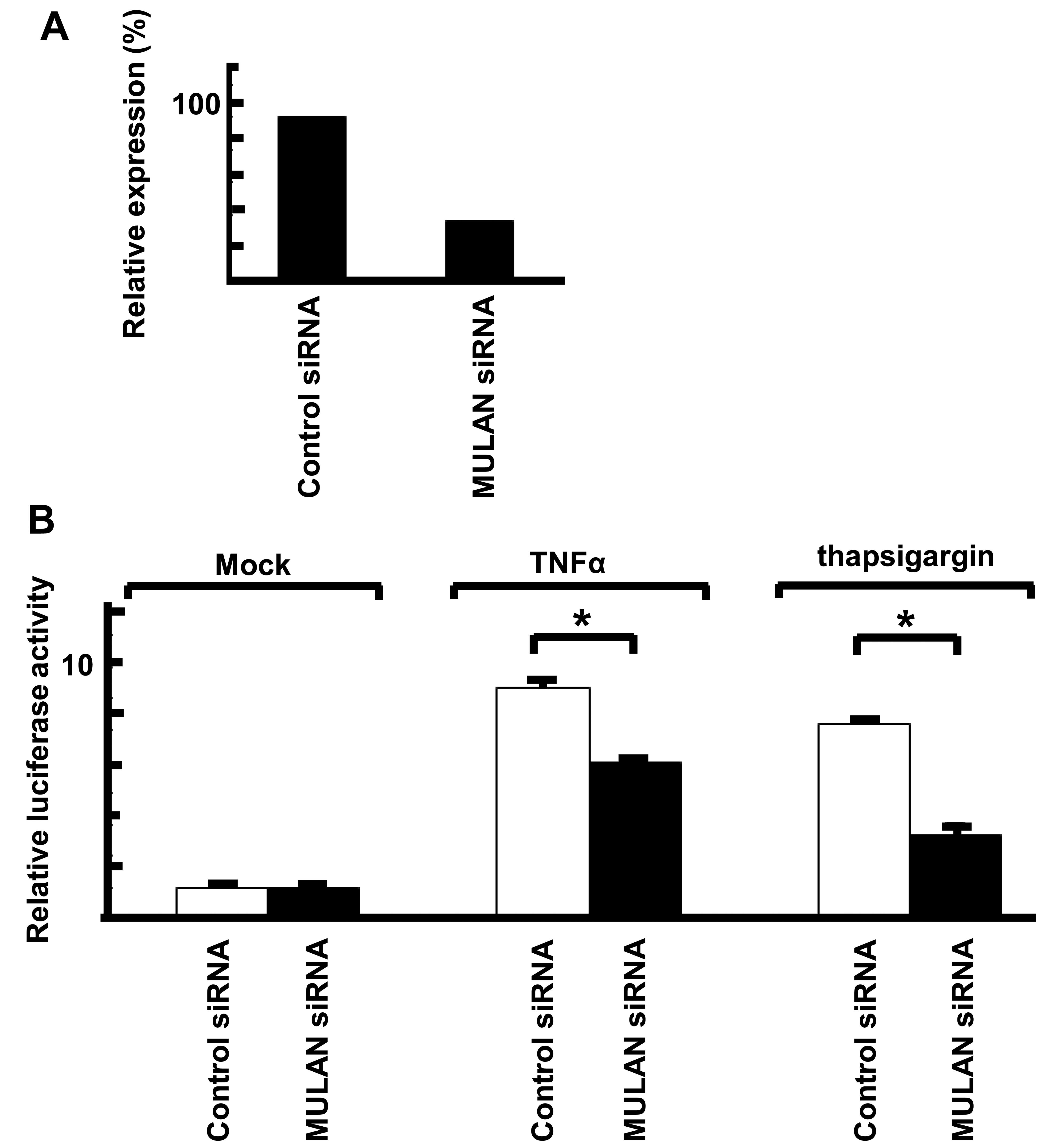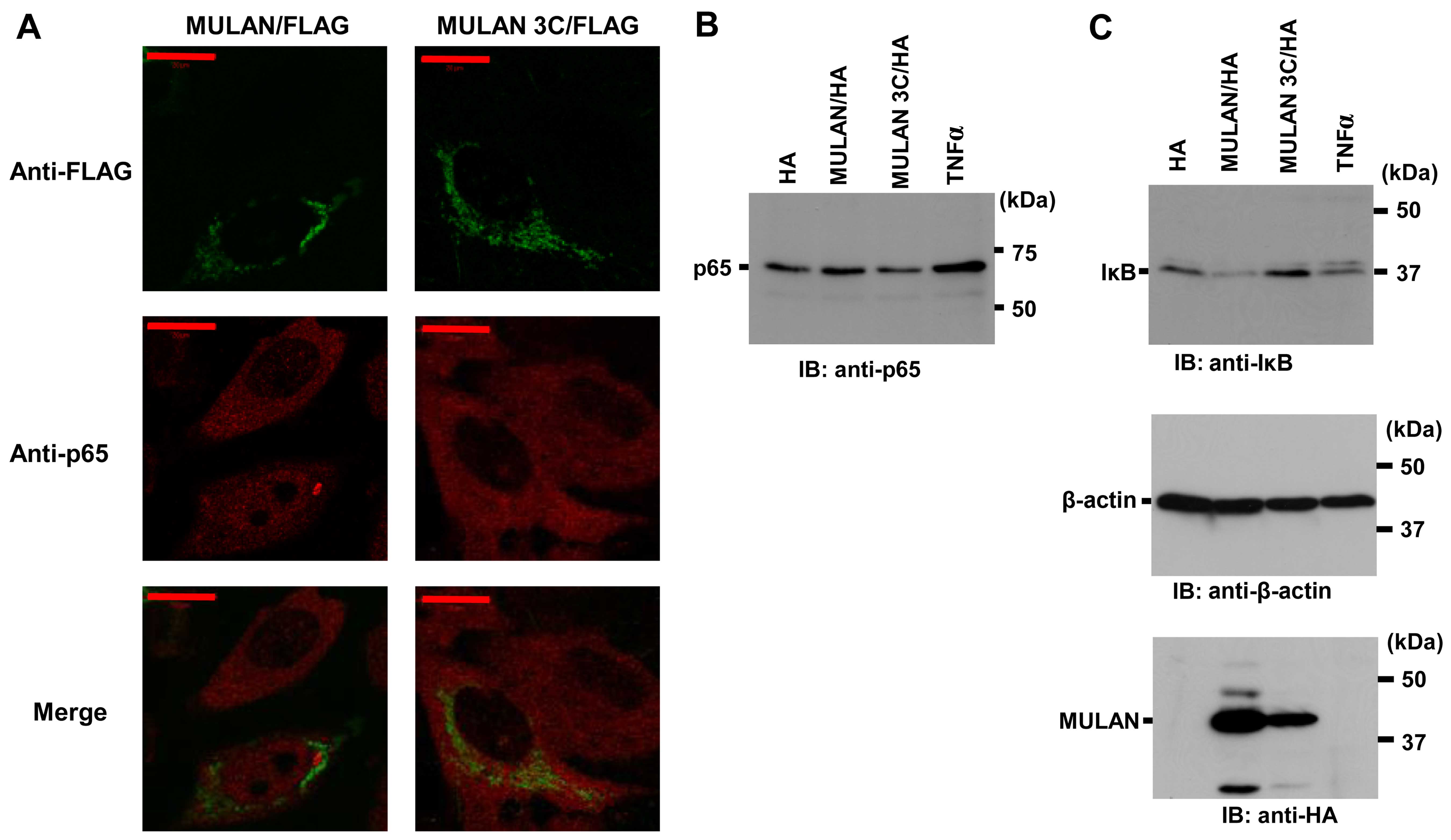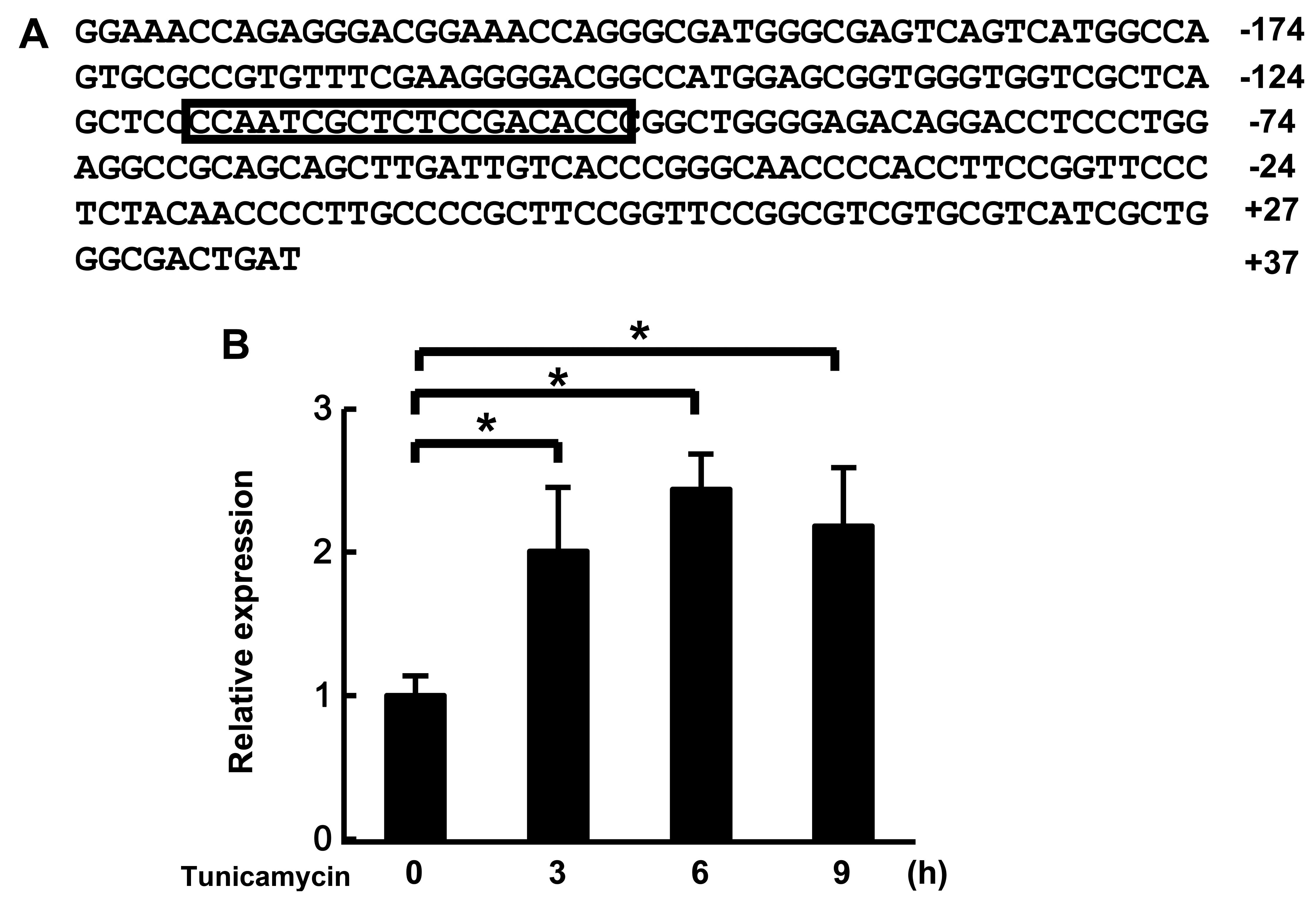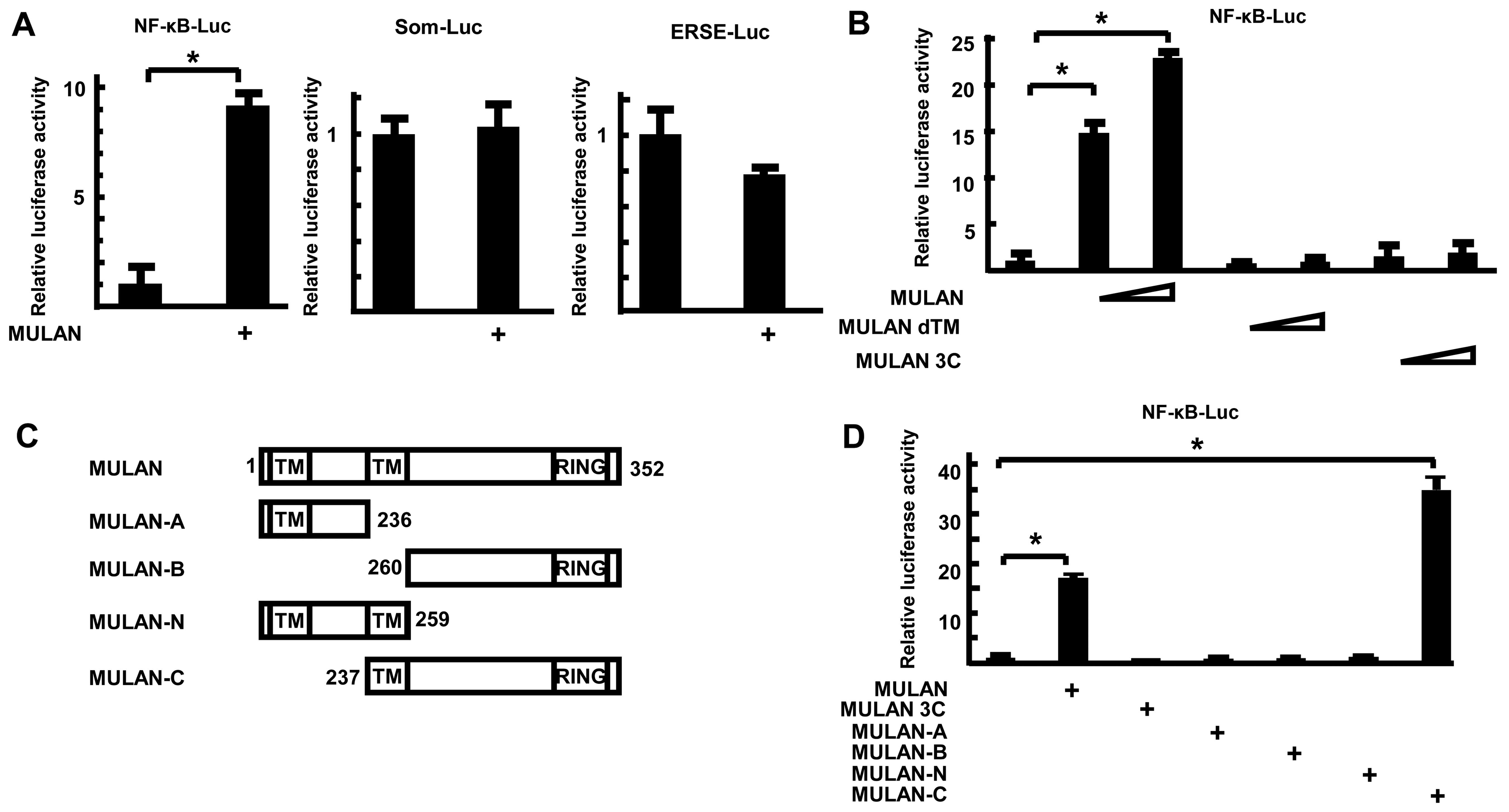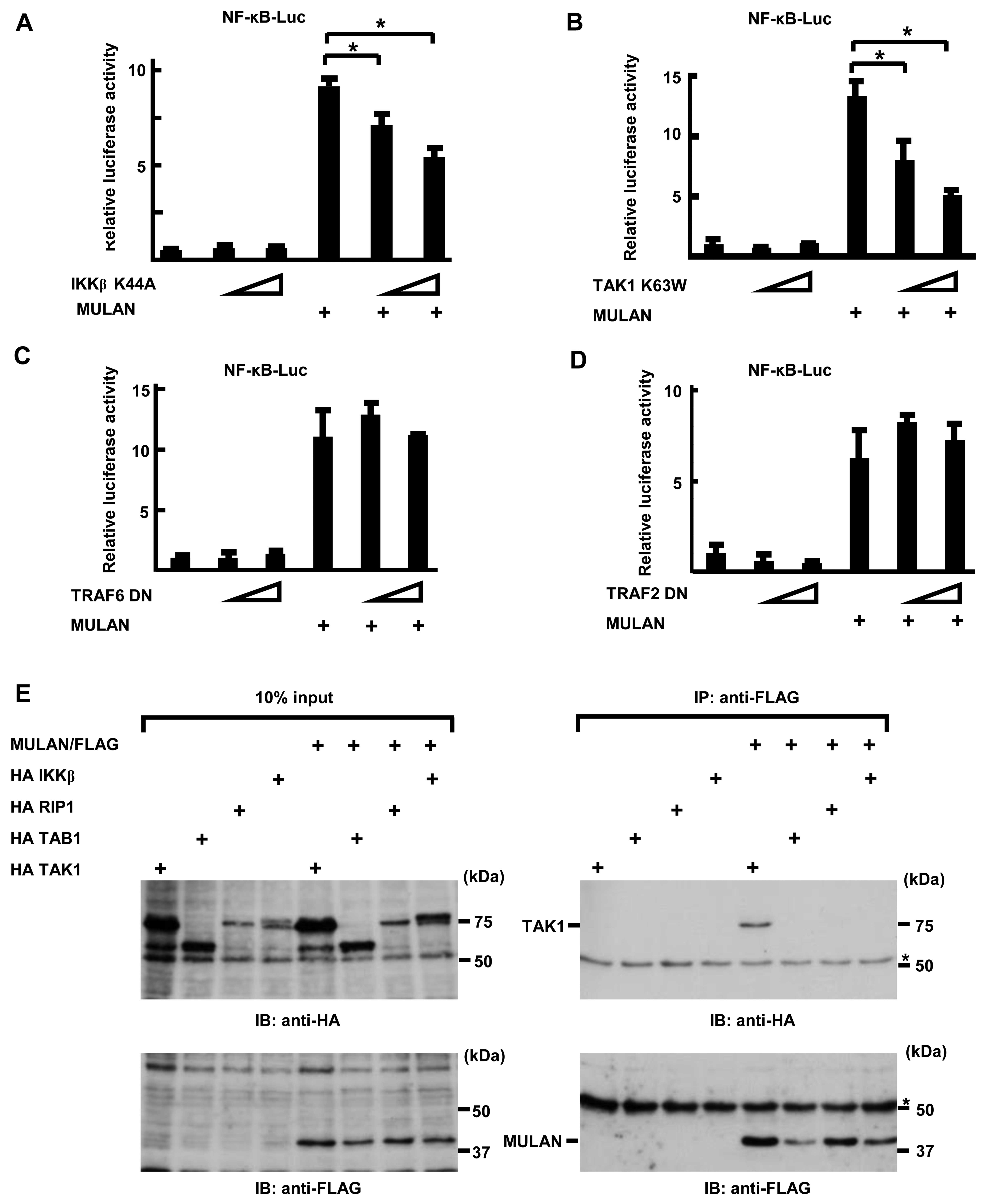Mitochondrial ubiquitin ligase activator of NF-κB regulates NF-κB signaling in cells subjected to ER stress
- Authors:
- Published online on: April 14, 2016 https://doi.org/10.3892/ijmm.2016.2566
- Pages: 1611-1618
Abstract
Introduction
Nuclear factor-κB (NF-κB) is a dimeric transcription factor that controls the expression of genes involved in multiple processes, including immunity, inflammation, apoptosis and cell cycle progression (1). Briefly, in resting cells, NF-κB is kept inactive in the cytoplasm by its association with the inhibitor of κBα (IκBα). Stimulating cells with an agonist, such as tumor necrosis factor α (TNFα) or interleukin (IL)-1β) activates the IκB kinase (IKK) complex, which is composed of two catalytic subunits, IKKα and IKKβ, and a regulatory subunit, NEMO. This signal-induced phosphorylation targets IκBα for Lys48-linked polyubiquitination and subsequent degradation by the ubiquitin-proteasome system (2,3). In this way, NF-κB is released from IκBα, and translocates into the nucleus to trigger the expression of its target genes. Recent studies have revealed several enzymes involved in the ubiquitination and deubiquitination of signaling proteins that mediate IKK activation through a degradation-independent mechanism (4). TNFR-associated factor (TRAF) proteins, ubiquitin E3 ligases (5) have a pivotal role in signaling pathways that are involved in the activation of NF-κB by many cell-surface receptors, including the TNFR superfamily, the IL-1 receptor (IL-1R) and Toll-like receptors (TLRs) (6). Following ligand binding to IL-1R or TLRs, TRAF6 is recruited to the receptor complexes and forms oligomers. TRAF6 oligomerization activates its ligase activity, leading to the Lys63-linked polyubiquitination of target proteins, including TRAF6 and NEMO. It is also known that receptor-interacting protein (RIP) is ubiquitinated by TRAF2 through the Lys63 linkage immediately following TNFα stimulation (7). Both the Lys63-linked polyubiquitylation of TRAF6 and RIP recruits transforming growth factor β (TGFβ)-activated kinase (TAK1) and two adaptor proteins, TAK1-binding protein (TAB)1 and TAB2. TAB2 contains a highly conserved novel zinc-finger domain that binds preferentially to polyubiquitin chains that are linked by Lys63 (8). TAB2-associated TAK1 phosphorylates IKKβ at two serine residues in the activation loop, thereby activating the IKK complex (9,10).
Ubiquitination has been shown to play important roles in the regulation of NF-κB signaling pathways, as well as in endoplasmic reticulum (ER) stress. There are two branches of ER quality control that address the situation. One is the unfolded protein response (UPR) pathway (11). The activation of UPR results in attenuation of protein synthesis, and upregulation of genes encoding chaperones that facilitate the protein folding process in the ER. Thus, UPR reduces the accumulation and aggregation of malfolded proteins, giving the cell the possibility of correcting the environment inside the ER (11,12). A second major response is known as the ER-associated degradation (ERAD) pathway to reduce the misfolded proteins in the ER, which involves retro-translocation, polyubiquitination and degradation in the cytosol through the 26S proteasome (13,14). Synoviolin, a representative ERAD-associated E3 ubiquitin ligase, is regulated by ER stress through the ER stress-response element (ERSE) which is a regulatory element located in many of these ER stress-response genes (15). Synoviolin, a mammalian homolog of Hrd1p/Der3p, was identified from the cDNA of rheumatoid synovial cells and is involved in the development of obesity, rheumatoid arthritis, fibrosis, limb girdle muscular dystrophy and liver cirrhosis (16–20).
In the present study, we searched for E3 ligases which are associated with ER stress and regulate NF-κB signaling. We identified an E3 ligase, mitochondrial ubiquitin ligase activator of NF-κB (MULAN). Previous studies have reported that MULAN is one of the NF-κB-activating genes by large scale screening (21), and regulates mitochondrial trafficking and morphology (22). In addition, mitochondrial hyperfusion promotes NF-κB activation in a TAK1- and IKK-dependent manner via MULAN (23). In this study, we found that the expression of MULAN is upregulated by ER stress. MULAN associates with TAK1 and activates NF-κB signaling in an E3 ligase activity-dependent manner. The knockdown of MULAN by siRNA resulted in the downregu-lation of NF-κB signaling in cells subjected to ER stress. Our results suggest that MULAN is an E3 ligase which regulates NF-κB signaling under conditions of ER stress.
Materials and methods
Plasmids
The coding sequences for full-length MULAN genes were PCR-amplified (primers, 5′-acagaattcATGGAGAGCGGAGGGC-3′ and 5′-tgtgtcgacGCTGTTGTACAGGGGTATCA-3′) from reversed-transcribed HeLa cell RNA. PCR products were digested with EcoRI and SalI, and ligated into pGEX-5X-1 (Amersham Pharmacia Biotechnology, Piscataway, NJ, USA) for in vitro ubiquitin (Ub) assays. For expression in mammalian cells, the fragments of MULAN and mutants were inserted into pcDNA3 hemagglutinin antigen (HA) or pcDNA3 FLAG, which were constructed by inserting the HA sequence or FLAG sequence into pcDNA3 (Invitrogen, Carlsbad, CA, USA), respectively. Fragments of deletion mutants, termed MULAN-A, MULAN-B, MULAN-N and MULAN-C were obtained by PCR amplification. Fragments of additional deletion mutants, termed MULAN delta transmembrane (dTM) and MULAN 3C were generated by PCR-based methods. The sequences of all plasmids generated by PCR were confirmed by sequence analysis. The IKKβ, IKKβ K44A, TRAF6, TRAF6 dominant negative (DN; delta RING), TRAF2, TRAF2 DN (delta RING) and RIP1 plasmids used in this study were obtained by a PCR-based method. The ERSE-Luc reporter plasmid was also obtained by a PCR-based method and possesses 4 copies of synoviolin ERSE. The TAK1, TAK1 K63W and TAB1 plasmids were a kindly gif from Dr Kunihiro Matsumoto. The pcDNA3 HA-Ub expression plasmid, NF-κB-Luc reporter plasmids, Som-Luc and CMV-β-gal plasmid have been described in previous studies (16,24–26).
Cell culture and antibodies
HeLa cells and 293 cells [provided by RIKEN BRC through the National Bio-Resource Project of MEXT (Ibaraki, Japan)] were maintained in Dulbecco's modified Eagle's medium supplemented with 10% fetal bovine serum plus penicillin and streptomycin at 37°C in 5% CO2. The following antibodies were used: anti-FLAG (M2; F3165) and anti-β-actin (A5441) from Sigma Chemical Co. (St. Louis, MO, USA), anti-HA [12CA5 (1583816) and 3F10 (1867423); Boehringer Mannheim GmbH, Mannheim, Germany], anti-IκB (sc-203) and anti-p65 (sc-372) were purchased from Santa Cruz Biotechnology, Inc., Santa Cruz, CA, USA.
Induction of ER stress
To induce ER stress, the cells were stimulated with tunicamycin at concentrations of 2 μg/ml for 0, 3, 6 and 9 h and total RNA was collected following stimulation. ER stress was also induced by thapsigargin in luciferase assay (Fig. 5). The cells were stimulated with thapsigargin at concentrations of 2 μM for 4 h.
TNFα and IL-1β treatment
TNFα is known to activate NF-κB signaling by promoting the degradation of IκBα and the nuclear translocation of p65. We treated the cells with TNFα at 10 nM for 4 h as a positive control (Fig. 4) and an inducer of NF-κB signaling (Fig. 5). IL-1β was also used at 10 ng/ml for 4 h.
Transfection and immunofluorescence
For immunofluorescence experiments, trypsinized cells were seeded on a cover glass and incubated for 24 h prior to transfection. Transfection was performed using Lipofectamine 2000 (Invitrogen) with 0.5 μg of MULAN expression plasmid, according to the manufacturer's instructions. The cells were incubated for a further 12 h after transfection, washed 3 times with phosphate-buffered saline (PBS), and fixed with 3.7% formaldehyde in PBS for 30 min, followed by permeabilization with 0.1% Triton X-100 for 30 min. The cells then were incubated with the primary antibody followed by staining with Alexa Fluor 488 anti-mouse second antibody or Alexa Fluor 594 anti-rabbit second antibody (Molecular Probes, Eugene, OR, USA). Samples were scanned with a Zeiss LSM 510 confocal laser scanning microscopy (Carl Zeiss Microscopy, Jena, Germany). Co-localization scatter diagrams were generated using LSM 510 software (27).
Transient transfection assay
Transient transfection assays were performed using the 293 cells, as previously described (24). The cells were lysed with cell lysis buffer (Toyo Ink, Tokyo, Japan) 24 h following transfection and luciferase activities were measured. The recorded activity was normalized to the β-gal activity from CMV-β-gal. All experiments were performed in triplicate. The 293 cells were transfected with 100 ng of NF-κB-Luc, 50 ng of CMV-β-gal control plasmid, and 0, 50 and 100 ng of MULAN or mutants, and/or DN-mutants plasmid, or truncated forms of MULAN expression vector. To ensure an equal amount of DNA, empty plasmids were added in each transfection.
Immunoprecipitation assay
The HeLa cells were transfected with HA TAK1, HA TAB1, HA RIP1, HA IKKβ, and/or MULAN/FLAG expression vector. After 12 h of transfection, the cells were lysed in 1 ml of lysis buffer (20 mM HEPES, pH 7.5, 100 mM NaCl, 1 mM EDTA, 1 mM DTT, 0.1% NP-40, 5% glycerol and protease inhibitors). The lysates were mixed with 1 μg of anti-FLAG antibody (M2) conjugated to protein G-sepharose beads (GE Healthcare Bio-Sciences, Uppsala, Sweden). Following 4 h of incubation at 4°C, the beads were washed 3 times with lysis buffer. Bound proteins were fractionated by sodium dodecyl sulfate-polyacrylamide gel electrophoresis (SDS-PAGE) and examined by western blot analysis.
Western blot analysis
The protein extracts were resolved by 10% SDS-PAGE, transferred onto a PVDF membrane, and incubated with primary antibodies [anti-FLAG M2 (F3165), anti-β-actin (A5441), anti-HA 3F10 (1867423), anti-IκB (sc-203) and anti-p65 (sc-372)] followed by horseradish peroxidase-conjugated secondary antibodies. The antigen-antibody complexes were visualized using an ECL detection system (Promega, Madison, WI, USA).
RNA interference assay, RT-PCR and real-time PCR
siRNAs (Stealth RNAi) for MULAN and GFP were purchased from Invitrogen. The sequence of the MULAN siRNA-1 was 5′-UUUCCACAAACUGGCUGUUAAGCGU-3′, and that of control siRNAwas 5′-AAGAAGUCGUGCUGCUUCAUGUGGU-3′. Transfection with siRNAs was carried out using Lipofectamine 2000 (Invitrogen) according to the manufacturer's instructions. Isogen was used for total RNA isolation and RT-PCR was performed with ReverTra Ace (Toyobo, Tokyo, Japan) according to the manufacturer's instructions. Total RNA (1 μg) was used for cDNA preparation. Real-time PCR was carried out using the Universal ProbeLibrary system (Roche Diagnostic, Mannheim, Germany). Signals from each sample were normalized to values obtained for the human glyceraldehyde 3-phosphate dehydrogenase (GAPDH) gene, which was assayed simultaneously with the experimental samples. Analyses were performed with a sequence detector (model 7500; Applied Biosystems, Foster City, CA, USA).
Statistical analysis
The non-paired Student's t-test was used to analyze mean differences. A P-value <0.05 was considered to indicate a statistically significant difference.
Results
MULAN is regulated by ER stress
Recent studies have revealed that ER stress induces the activation of NF-κB (36,37). It is well known that ubiquitination is critical in both the response to ER stress and NF-κB activation. Therefore, we wished to determine whether E3 ligases, which are related to ER stress, regulate NF-κB signaling. We found the putative ERSE located at positions −118 to −100 on the promoter region of MULAN, which is one of the NF-κB-activating genes (Fig. 1A). First, we analyzed the mRNA expression of MULAN in cells subjected to ER stress by real-time PCR. MULAN mRNA expression was increased by the induction of ER stress by stimulation with tunicamycin (Fig. 1B). These results suggest that the expression of MULAN is regulated by ER stress.
MULAN activates NF-κB gene expression in an E3 ligase activity-dependent manner
To determine whether MULAN specifically activates NF-κB-Luc, the luciferase reporter plasmids were co-transfected with MULAN/HA-expressing plasmid into the 293 cells. Twenty-four hours after transfection, the luciferase activities were measured. MULAN enhanced the reporter activity of NF-κB-Luc, but not that of Som-Luc and ERSE-Luc (Fig. 2A). To further examine the mechanism of induction of NF-κB-dependent gene expression by MULAN, we utilized several mutants of MULAN and performed reporter assays. MULAN increased NF-κB-dependent gene expression by 21.9-fold in a dose-dependent manner (Fig. 2B). By contrast, dTM, which lacks the second transmembrane domain, and MULAN 3C, which includes a cysteine to serine substitution in the RING finger domain and lacks E3 ubiquitin ligase activity, did not stimulate the reporter activity. To determine which domains contributes to the activation of NF-κB-Luc, several truncations of MULAN were expressed as HA fusion proteins (Fig. 2C) and examined by reporter assay. MULAN induced the reporter activity 16.4-fold. Among these 4 mutants, only MULAN-C markedly activated transcription 33.4-fold, whereas MULAN-A, MULAN-B and MULAN-N did not (Fig. 2D). These results suggest that both the transmembrane domain (TM) and RING finger domain are important for the MULAN-dependent activation of NF-κB.
The mechanism of MULAN-dependent NF-κB activation
To further investigate the target of MULAN, we utilized dominant negative (DN) mutants of major factors in NF-κB signals, such as IKKβ, TAK1, TRAF6 and TRAF2. First, we examined the inhibitory effects of these DN mutants in TNFα-treated cells, and we found that they suppressed the reporter activity of NF-κB-Luc in a dose-dependent manner. As shown in Fig. 3A, the introduction of DN-IKKβ plasmids markedly inhibited the MULAN-induced activation of NF-κB in a dose-dependent manner. In addition, transfection with DN-TAK1 also yielded the same result (Fig. 3B). Conversely, DN-TRAF2 and DN-TRAF6 failed to suppress the MULAN-dependent activation of NF-κB (Fig. 3C and D). These results suggest that MULAN plays a role in NF-κB activation upstream of TAK1 and downstream of TRAF2 and TRAF6. These results prompted us to search the interactants of MULAN. To determine whether MULAN interacts with TAK1 TAB1, RIP1 and IKKβ, we transiently transfected HeLa cells with HA TAK1, HA TAB1, HA RIP1, HA IKKβ expression plasmids and/or MULAN/FLAG expression plasmids. We performed an immunoprecipitation assay following western blot analysis. As shown in Fig. 3E (upper panel), HA TAK1 was detected in the immunoprecipitate with anti-FLAG antibody, but HA TAB1, HA RIP1 and HA IKKβ were not. These results suggest that TAK1 may be one of the targets of MULAN through which it induces the activation of NF-κB.
MULAN activates endogenous NF-κB signals
It is well known that the NF-κB signaling pathway can be activated through various processes; however, the release of cytoplasmic NF-κB proteins from IκB proteins and nuclear translocation are pivotal for signal transduction (28). To determine whether MULAN induces endogenous NF-κB activation, we observed the translocation of endogenous p65 into the nucleus. MULAN/FLAG or MULAN 3C/FLAG were transiently transfected into the HeLa cells. The nuclear localization of endogenous p65 was only observed in the cells that expressed MULAN/FLAG (Fig. 4A). To further confirm the nuclear localization of p65, we used nuclear extraction and western blot analysis with anti-p65 specific antibody. In the cells transfected with the pcDNA3 HA vector or MULAN 3C/HA expression vector, a small amount of p65 was found in the nuclear extracts. On the other hand, stimulation with TNFα and the expression of MULAN led to an increase in p65 levels in the nucleus (Fig. 4B). We then examined the degradation of endogenous IκBα. We transfected MULAN/HA or MULAN 3C/HA into the HeLa cells, and cell lysates were prepared 12 h following transfection. In the cells transfected with pcDNA3 HA vector or MULAN 3C/HA, hardly any IκBα degradation was observed, whereas noticeable degradation was detected in the cells expressing wild-type MULAN (Fig. 4C). These results indicate that MULAN activates NF-κB-dependent gene expression in an enzymatic activity-dependent manner.
Knockdown of MULAN induces a decrease in ER stress-dependent NF-κB activity
To examine the upper signal of MULAN-dependent NF-κB activation, we performed reporter assay with siRNA against MULAN. To confirm the effects of siRNAs, MULAN siRNA and control siRNA were transiently transfected into the HeLa cells. After 48 h, total RNA was isolated and the mRNA levels were measured by real-time PCR. MULAN siRNA induced the downregulation of MULAN (Fig. 5A). We then performed a reporter assay with NF-κB-Luc. The cells stimulated with TNFα and transfected with control siRNA exhibited an enhanced reporter activity by 7.3-fold and the MULAN siRNA-transfected cells exhibited a low reporter activity (Fig. 5B). We also observed no difference in reporter activity when the cells were stimulated with IL-1β (data not shown). When the cells were treated with thapsigargin, a decrease in reporter activity of approximately 50% was observed in the MULAN siRNA-transfected cells compared with the cells transfected with control siRNA. These results indicate that the activation of NF-κB by MULAN plays an important in cells subjected to ER stress.
Discussion
MULAN is regulated by ER stress
We found putative ERSE on the promoter region of MULAN gene (Fig. 1). ERSE is found in many of these ER stress-response genes and is regulated by the ER responsive transcriptional factors, activating transcription factor 6 (ATF6) and X-box binding protein 1 (XBP1). ERSE, with a consensus sequence of CCAAT-N9-CCACG, is a cis-acting element that is necessary and sufficient for transcriptional induction of ER chaperone genes (29–31). The putative ERSE of MULAN, CCAAT-N9-ACACC, differs slighlty from the consensus sequence of ERSE. Many ER stress-responsive genes also have a different ERSE from a consensus sequence; for example, Bip/Grp78, CCAAT-N9-CCAAC and PDI, CCAGT-N9-ACAGC. In addition, the expression of MULAN was induced by ER stress (Fig. 1). However, we cannot not rule out possibility of the contribution of other elements on the MULAN promoter. These results suggest that the putative ERSE of MULAN may function as an ERSE and it is certain that MULAN plays a role in the response to ER stress.
The mechanism of MULAN-induced NF-κB activation
Ubiquitination is important in NF-κB activation. It has been demonstrated that TRAF2, which is recruited to the TNFR complex, ubiquitinates RIP, and polyubiquitinated RIP associates with TNFR as well as with TAB2 (8,32,33). These studies suggest that the polyubiquitination of RIP recruits the TAK1-TAB2 complex, which subsequently activates the IKK complex. It has been shown that TRAF6 recruited to the receptor complexes polyubiquitinates these complexes, and polyubiquitinated TRAF6 associates with the TAB2/TAB1/TAK1 complex (8). In this study, we revealed that MULAN activated NF-κB dependent transcription via E3 ubiquitin ligase activity. The activation of NF-κB via MULAN was inhibited by IKK DN and TAK1 DN, but not by TRAF2 and TRAF6. In addition, our binding assay revealed that MULAN associated with TAK1. TAK1 has been reported to be induced by polyubiquitination. TAK1 has Lys63-linked ubiquitination sites and the polyubiquitination of TAK1 induces IK-dependent NF-κB activation (34,35). Therefore, it is possible that MULAN may induce the polyubiqutination of TAK1 to activate NF-κB signaling.
MULAN-induced NF-κB activation in cells subjected to ER stress
The ER stress-induced activation of NF-κB has been demonstrated to be involved in both the protection of cells from ER stress-induced apoptosis (36) and in the induction of apoptosis (37). TRAF2 mediates the activation of both the c-Jun N-terminal kinase (JNK)/stress-activated protein kinase (SAPK) and the NF-κB pathways following ER stress (38,39). Therefore, TRAF2 simultaneously mediates the activation of the NF-κB survival pathway and the pro-apoptotic JNK pathway, and the fate of the cell would be determined by the interplay between these opposing signals. TAK1 also activates both the NF-κB survival pathway and the pro-apoptotic JNK pathway. The activation of TAK1 is induced by K63-linked polyubiquitination reactions by TRAF2 or TRAF6 at the K158, K34 and K209 residues (35). Recently, Lys562 of TAK1 was identified as a novel Lys63-linked ubiquitination site. The accumulation of polyubiquitination at Lys562 induces IKK-dependent NF-κB activation, but not JNK/p38 pathway activation (34). In this study, MULAN activated NF-κB dependent gene expression, and the expression of MULAN was regulated by ER stress. In addition, the MULAN-dependent NF-κB activation was TAK1-dependent and MULAN interacted with TAK1. We thus hypothesized that MULAN may induce NF-κB activation via TAK1 for cell survival following ER stress; MULAN may activate NF-κB-dependent gene expression by the induction of de novo MULAN by ER stress.
In conclusion, in the present study we provide evidence that MULAN is an E3 ligase that mediates NF-κB-dependent gene expression in cells subjected to ER stress. Further analysis of MULAN will be helpful in order to broaden our understanding of the physiological significance of MULAN and of the mechanisms of NF-κB activation by MULAN.
Abbreviations:
|
TAK1 |
transforming growth factor β-activated kinase |
|
MULAN |
mitochondrial ubiquitin ligase activator of nuclear factor-κB |
|
ERSE |
endoplasmic reticulum stress-response element |
|
TRAF |
tumor necrosis factor receptor-associated factor |
|
IκBα |
inhibitor of κBα |
|
IKK |
IκB kinase |
Acknowledgments
We would like to thank Dr Kunihiro Matsumoto for kindly providing the TAK1, TAK1 K63W and TAB1 expression vectors. We would also like to thank Ms. Yukari Nakagawa and Mrs. Sanae Shinkawa for their technical assistance and the members of the Nakajima Laboratory for their helpful comments on our manuscript. This study was funded in part by grants from the Naito Foundation, Inoue Foundation for Science, Natural Science Scholarship Daiichi-Sankyo Foundation of Life Science, Mitsubishi Tanabe Pharma Corporation, Bureau of Social Welfare and Public Health, Academic contribution of Pfizer, Eisai, Asahi Kasei Pharma, Abbvie, Santen, Takeda Science Foundation and AstraZeneca (R&D grant 2013). This study was supported in part by funds provided through an MEXT-Supported program of the Strategic Research Foundation at Private Universities (nos. S1411011 and 2014–2018) from the Ministry of Education, Culture, Sports, Science and Technology of Japan. This study was also supported in part by the Japan Society for the Promotion of Science KAKENHI and Industry-university cooperation (BioMimetics Sympathies Inc., Tokyo, Japan).
References
|
Karin M and Lin A: NF-kappaB at the crossroads of life and death. Nat Immunol. 3:221–227. 2002. View Article : Google Scholar : PubMed/NCBI | |
|
Chen Z, Hagler J, Palombella VJ, Melandri F, Scherer D, Ballard D and Maniatis T: Signal-induced site-specific phosphorylation targets I kappa B alpha to the ubiquitin-proteasome pathway. Genes Dev. 9:1586–1597. 1995. View Article : Google Scholar : PubMed/NCBI | |
|
Karin M and Ben-Neriah Y: Phosphorylation meets ubiquitination: The control of NF-[kappa]B activity. Annu Rev Immunol. 18:621–663. 2000. View Article : Google Scholar | |
|
Chen ZJ: Ubiquitin signalling in the NF-kappaB pathway. Nat Cell Biol. 7:758–765. 2005. View Article : Google Scholar : PubMed/NCBI | |
|
Deng L, Wang C, Spencer E, Yang L, Braun A, You J, Slaughter C, Pickart C and Chen ZJ: Activation of the IkappaB kinase complex by TRAF6 requires a dimeric ubiquitin-conjugating enzyme complex and a unique polyubiquitin chain. Cell. 103:351–361. 2000. View Article : Google Scholar : PubMed/NCBI | |
|
Chung JY, Park YC, Ye H and Wu H: All TRAFs are not created equal: Common and distinct molecular mechanisms of TRAF-mediated signal transduction. J Cell Sci. 115:679–688. 2002.PubMed/NCBI | |
|
Wertz IE, O'Rourke KM, Zhou H, Eby M, Aravind L, Seshagiri S, Wu P, Wiesmann C, Baker R, Boone DL, et al: De-ubiquitination and ubiquitin ligase domains of A20 downregulate NF-kappaB signalling. Nature. 430:694–699. 2004. View Article : Google Scholar : PubMed/NCBI | |
|
Kanayama A, Seth RB, Sun L, Ea CK, Hong M, Shaito A, Chiu YH, Deng L and Chen ZJ: TAB2 and TAB3 activate the NF-kappaB pathway through binding to polyubiquitin chains. Mol Cell. 15:535–548. 2004. View Article : Google Scholar : PubMed/NCBI | |
|
Wang C, Deng L, Hong M, Akkaraju GR, Inoue J and Chen ZJ: TAK1 is a ubiquitin-dependent kinase of MKK and IKK. Nature. 412:346–351. 2001. View Article : Google Scholar : PubMed/NCBI | |
|
Ninomiya-Tsuji J, Kishimoto K, Hiyama A, Inoue J, Cao Z and Matsumoto K: The kinase TAK1 can activate the NIK-I kappaB as well as the MAP kinase cascade in the IL-1 signalling pathway. Nature. 398:252–256. 1999. View Article : Google Scholar : PubMed/NCBI | |
|
Kaufman RJ: Stress signaling from the lumen of the endoplasmic reticulum: Coordination of gene transcriptional and translational controls. Genes Dev. 13:1211–1233. 1999. View Article : Google Scholar : PubMed/NCBI | |
|
Sitia R and Braakman I: Quality control in the endoplasmic reticulum protein factory. Nature. 426:891–894. 2003. View Article : Google Scholar : PubMed/NCBI | |
|
Kopito RR: ER quality control: The cytoplasmic connection. Cell. 88:427–430. 1997. View Article : Google Scholar : PubMed/NCBI | |
|
Plemper RK and Wolf DH: Retrograde protein translocation: ERADication of secretory proteins in health and disease. Trends Biochem Sci. 24:266–270. 1999. View Article : Google Scholar : PubMed/NCBI | |
|
Hu MC, Gong HY, Lin GH, Hu SY, Chen MH, Huang SJ, Liao CF and Wu JL: XBP-1, a key regulator of unfolded protein response, activates transcription of IGF1 and Akt phosphorylation in zebrafish embryonic cell line. Biochem Biophys Res Commun. 359:778–783. 2007. View Article : Google Scholar : PubMed/NCBI | |
|
Amano T, Yamasaki S, Yagishita N, Tsuchimochi K, Shin H, Kawahara K, Aratani S, Fujita H, Zhang L, Ikeda R, et al: Synoviolin/Hrd1, an E3 ubiquitin ligase, as a novel pathogenic factor for arthropathy. Genes Dev. 17:2436–2449. 2003. View Article : Google Scholar : PubMed/NCBI | |
|
Li L, Shen Y, Ding Y, Liu Y, Su D and Liang X: Hrd1 participates in the regulation of collagen I synthesis in renal fibrosis. Mol Cell Biochem. 386:35–44. 2014. View Article : Google Scholar | |
|
Bianchini E, Fanin M, Mamchaoui K, Betto R and Sandonà D: Unveiling the degradative route of the V247M α-sarcoglycan mutant responsible for LGMD-2D. Hum Mol Genet. 23:3746–3758. 2014. View Article : Google Scholar : PubMed/NCBI | |
|
Fujita H, Yagishita N, Aratani S, Saito-Fujita T, Morota S, Yamano Y, Hansson MJ, Inazu M, Kokuba H, Sudo K, et al: The E3 ligase synoviolin controls body weight and mitochondrial biogenesis through negative regulation of PGC-1β. EMBO J. 34:1042–1055. 2015. View Article : Google Scholar : PubMed/NCBI | |
|
Hasegawa D, Fujii R, Yagishita N, Matsumoto N, Aratani S, Izumi T, Azakami K, Nakazawa M, Fujita H, Sato T, et al: E3 ubiquitin ligase synoviolin is involved in liver fibrogenesis. PLoS One. 5:e135902010. View Article : Google Scholar : PubMed/NCBI | |
|
Matsuda A, Suzuki Y, Honda G, Muramatsu S, Matsuzaki O, Nagano Y, doi T, Shimotohno K, Harada T, Nishida E, et al: Large-scale identification and characterization of human genes that activate NF-kappaB and MAPK signaling pathways. Oncogene. 22:3307–3318. 2003. View Article : Google Scholar : PubMed/NCBI | |
|
Li W, Bengtson MH, Ulbrich A, Matsuda A, Reddy VA, Orth A, Chanda SK, Batalov S and Joazeiro CA: Genome-wide and functional annotation of human E3 ubiquitin ligases identifies MULAN, a mitochondrial E3 that regulates the organelle's dynamics and signaling. PLoS One. 3:e14872008. View Article : Google Scholar : PubMed/NCBI | |
|
Zemirli N, Pourcelot M, Ambroise G, Hatchi E, Vazquez A and Arnoult D: Mitochondrial hyperfusion promotes NF-κB activation via the mitochondrial E3 ligase MULAN. FEBS J. 281:3095–3112. 2014. View Article : Google Scholar : PubMed/NCBI | |
|
Fujita H, Fujii R, Aratani S, Amano T, Fukamizu A and Nakajima T: Antithetic effects of MBD2a on gene regulation. Mol Cell Biol. 23:2645–2657. 2003. View Article : Google Scholar : PubMed/NCBI | |
|
Nakajima T, Fukamizu A, Takahashi J, Gage FH, Fisher T, Blenis J and Montminy MR: The signal-dependent coactivator CBP is a nuclear target for pp90RSK. Cell. 86:465–474. 1996. View Article : Google Scholar : PubMed/NCBI | |
|
Nakajima T, Uchida C, Anderson SF, Lee CG, Hurwitz J, Parvin JD and Montminy M: RNA helicase A mediates association of CBP with RNA polymerase II. Cell. 90:1107–1112. 1997. View Article : Google Scholar : PubMed/NCBI | |
|
Fujita H, Ohshima T, Oishi T, Aratani S, Fujii R, Fukamizu A and Nakajima T: Relevance of nuclear localization and functions of RNA helicase. A Int J Mol Med. 15:555–560. 2005. | |
|
Hoffmann A and Baltimore D: Circuitry of nuclear factor kappaB signaling. Immunol Rev. 210:171–186. 2006. View Article : Google Scholar : PubMed/NCBI | |
|
Roy B and Lee AS: The mammalian endoplasmic reticulum stress response element consists of an evolutionarily conserved tripartite structure and interacts with a novel stress-inducible complex. Nucleic Acids Res. 27:1437–1443. 1999. View Article : Google Scholar : PubMed/NCBI | |
|
Yoshida H, Haze K, Yanagi H, Yura T and Mori K: Identification of the cis-acting endoplasmic reticulum stress response element responsible for transcriptional induction of mammalian glucose-regulated proteins. Involvement of basic leucine zipper transcription factors. J Biol Chem. 273:33741–33749. 1998. View Article : Google Scholar : PubMed/NCBI | |
|
Yoshida H, Okada T, Haze K, Yanagi H, Yura T, Negishi M and Mori K: ATF6 activated by proteolysis binds in the presence of NF-Y (CBF) directly to the cis-acting element responsible for the mammalian unfolded protein response. Mol Cell Biol. 20:6755–6767. 2000. View Article : Google Scholar : PubMed/NCBI | |
|
Lee TH, Shank J, Cusson N and Kelliher MA: The kinase activity of Rip1 is not required for tumor necrosis factor-alpha-induced IkappaB kinase or p38 MAP kinase activation or for the ubiqui-tination of Rip1 by Traf2. J Biol Chem. 279:33185–33191. 2004. View Article : Google Scholar : PubMed/NCBI | |
|
Legler DF, Micheau O, Doucey MA, Tschopp J and Bron C: Recruitment of TNF receptor 1 to lipid rafts is essential for TNFalpha-mediated NF-kappaB activation. Immunity. 18:655–664. 2003. View Article : Google Scholar : PubMed/NCBI | |
|
Chen IT, Hsu PH, Hsu WC, Chen NJ and Tseng PH: Polyubiquitination of transforming growth factor β-activated kinase 1 (TAK1) atlysine 562 residue regulates TLR4-mediated JNK and p38 MAPK activation. Sci Rep. 5:123002015. View Article : Google Scholar | |
|
Ajibade AA, Wang HY and Wang RF: Cell type-specific function of TAK1 in innate immune signaling. Trends Immunol. 34:307–316. 2013. View Article : Google Scholar : PubMed/NCBI | |
|
Mauro C, Crescenzi E, De Mattia R, Pacifico F, Mellone S, Salzano S, de Luca C, D'Adamio L, Palumbo G, Formisano S, et al: Central role of the scaffold protein tumor necrosis factor receptor-associated factor 2 in regulating endoplasmic reticulum stress-induced apoptosis. J Biol Chem. 281:2631–2638. 2006. View Article : Google Scholar | |
|
Hu P, Han Z, Couvillon AD, Kaufman RJ and Exton JH: Autocrine tumor necrosis factor alpha links endoplasmic reticulum stress to the membrane death receptor pathway through IRE1alpha-mediated NF-kappaB activation and downregulation of TRAF2 expression. Mol Cell Biol. 26:3071–3084. 2006. View Article : Google Scholar : PubMed/NCBI | |
|
Leonardi A, Vito P, Mauro C, Pacifico F, Ulianich L, Consiglio E, Formisano S and Di Jeso B: Endoplasmic reticulum stress causes thyroglobulin retention in this organelle and triggers activation of nuclear factor-kappa B via tumor necrosis factor receptor-associated factor 2. Endocrinology. 143:2169–2177. 2002.PubMed/NCBI | |
|
Urano F, Wang X, Bertolotti A, Zhang Y, Chung P, Harding HP and Ron D: Coupling of stress in the ER to activation of JNK protein kinases by transmembrane protein kinase IRE1. Science. 287:664–666. 2000. View Article : Google Scholar : PubMed/NCBI |



